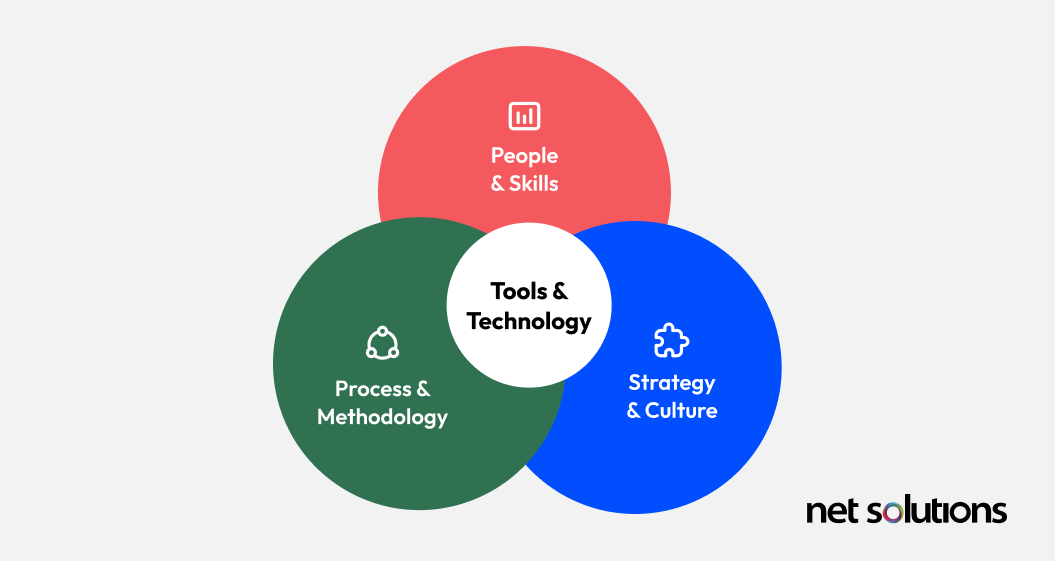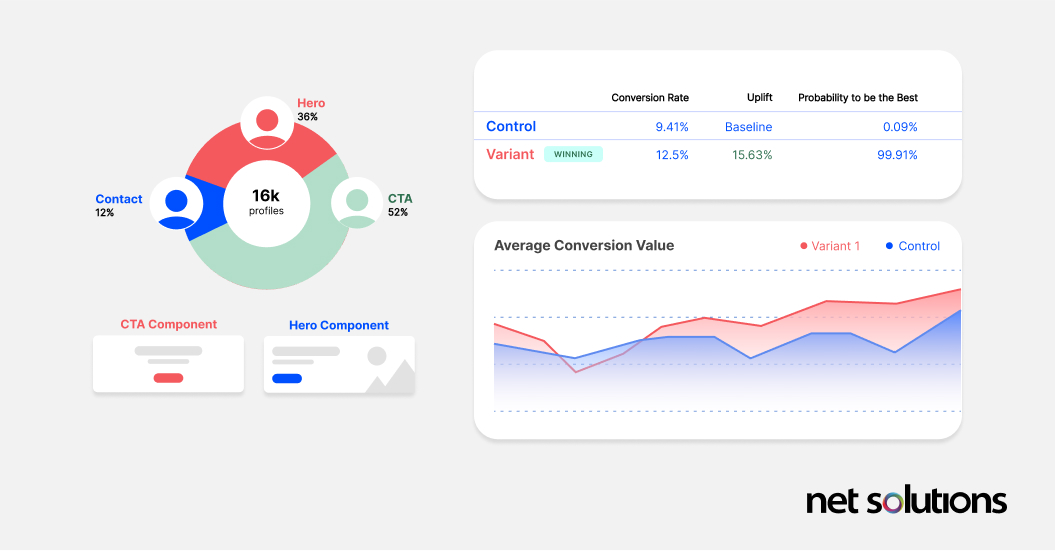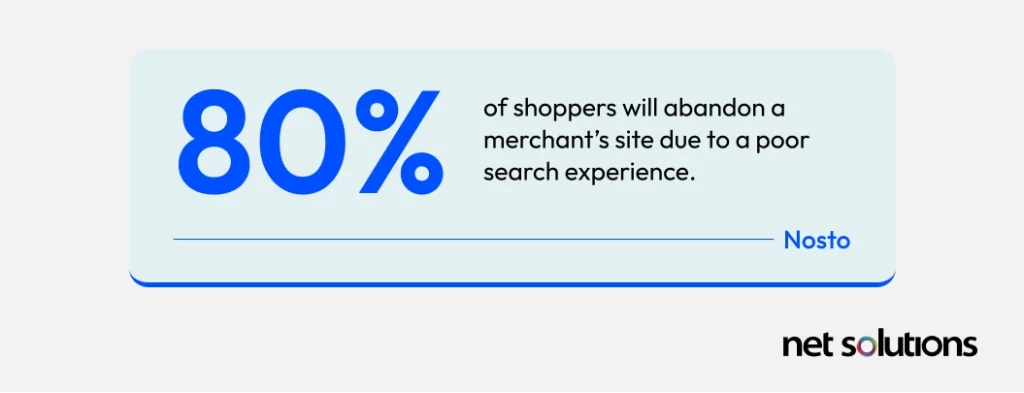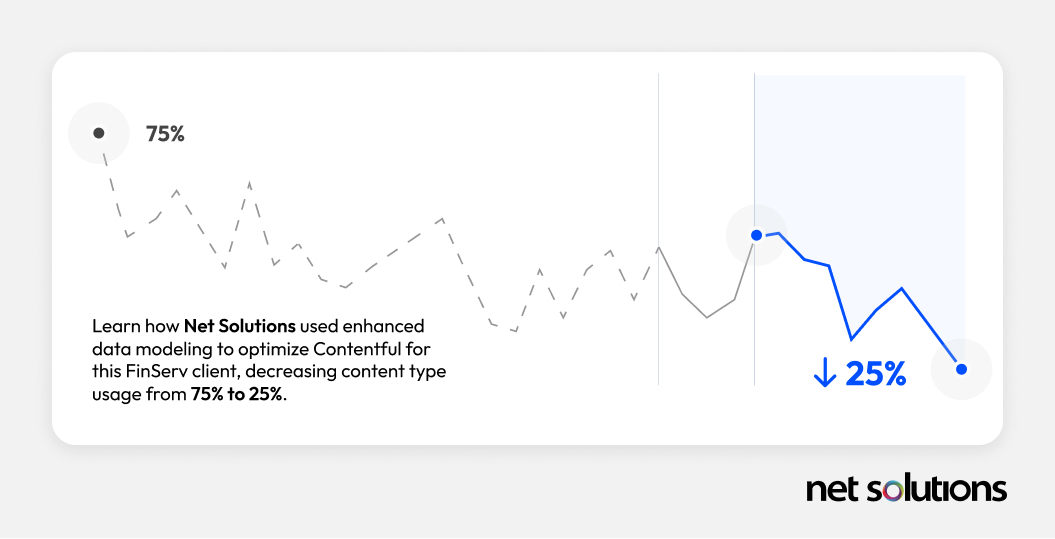You spend a lot of money to attract website visitors, but you don’t see a return on that investment unless those people buy from you. Conversion rate optimization (CRO) is the process of increasing the number of qualified leads or consumers of the product or service you’re selling—because incremental improvements in conversion fuel the growth of your business.
This guide will demonstrate how to optimize your content management system (CMS)—Contentful—to support your CRO efforts. We will talk about specific best practices, modifications, and extensions you can leverage to improve your success with Contentful, including:
- How technology such as Contentful forms the foundation of CRO
- The critical importance of your data model
- How to leverage the Ninetailed personalization engine within Contentful to drive conversion
- How to leverage workflow automations to support efficiency and collaboration
- How data and analytics can inform sales, marketing, and future business strategy
- The importance of developing and supplementing skills to harness tools & technology to support CRO efforts
How Your CMS Can Influence Conversion
Conversion is tied to how well you convey your value proposition—demand, trust, value, relevance, urgency—and how well your website and its content meets consumer expectations—for performance, personalization, and overall user experience (UX). CRO is the process of maximizing all these variables across your website as a whole, individual pages or processes (e.g., checkout), and/or individual channels (e.g., mobile).
Paul Rouke & Paul Postance created a model to express CRO as a combination of four pillars: strategy and culture, tools and technology, people and skills, and process and methodology. However, we believe that the concept of “pillars” fails to reflect the foundational nature of tools and technology, which have a strong influence on people and processes and which provide the foundation for a data-driven strategy. Further, each remaining pillar interacts with and influences the other core principles of CRO.

- Tools & Technology – Having the right tools, as well as the process and skills to maximize the use of the tools.
- People & Skills – Having a multi-disciplinary team to drive CRO efforts, supported by AI tools and strategic partnerships to close skill gaps across critical areas: development, UX, strategy, or content development.
- Process & Methodology – Ensuring critical pipelines are efficient (dev, design, content) and that you are capturing the correct data, running the proper tests, leveraging the right analytics, and automating as much of it as possible.
- Strategy – Ensuring business goals drive CRO efforts and that tools and processes continually funnel real-time critical data back to support decision-making.
As you can see, technology is interwoven into all areas of CRO optimization, but what do we mean by technology? Within the eCommerce space, the central spoke of your tech stack is the hub that drives your commerce activities, ensuring you can deliver consistent and personalized shopping experiences to shoppers on any channel.
That brings us to Contentful, a composable content platform that allows you to combine and integrate commerce components (inventory, payment gateways, eCommerce, analytics) to support your commerce needs—and your critical CRO efforts. As the central hub for your commerce activities, pulling products directly into Contentful for use in content (e.g. BigCommerce’s integration), Contentful is designed to orchestrate your commerce ecosystem and help you remain agile to changing technologies and consumer expectations.
In the remainder of this guide, we’ll show you how you can make the most of your Contentful implementation to drive your CRO efforts.
Note, while we may think of conversion as making a purchase, you may also track conversion for opening an account, filling out a form, or signing up for a newsletter (among other options).
Practical Strategies for Boosting Conversion Rates with Contentful
Contentful is a powerful CMS designed to help you rapidly build experiences at scale—but using Contentful does not guarantee conversion as technology is just one of the “pillars” or elements that drive CRO efforts. However, as illustrated above, you can customize, optimize, and build upon Contentful to support your people, processes, and strategic efforts.
1. Structure Your Content Model for Reusability
Your content model is the basis of your success in Contentful, and it remains one of the top challenges that Contentful developers face, according to our recent survey. How you set up your content model can hinder your CRO efforts, including:
- Slowed pipelines that hinder CRO agility, if developers need to be involved to support missing content types
- Editorial inconsistencies that impact UX, if content types or fields are confusing
- Slow page performance, if too many content fields are used as each requires a database query
- Rigidity in design, restricting adjustments that could be made to optimize CRO based on testing feedback (e.g. heatmaps)
- Database optimization missing, a missed opportunity to reduce content type usage to increase performance
Every content model is unique, and Contentful’s AI Content Type Generator is a good starting place, but you can further your CRO efforts by following the best practices we outline in our Contentful migration guide, including:
- Make content types as reusable as possible vs creating new content types, which includes a careful use of fields (e.g., hero section, CTAs), but with enough wiggle room for experimentation.
- Use clear, consistent naming practices for types and fields to support the editorial pipeline and editorial consistency.
- Create dedicated content models for product details (e.g., product name, description, SKU, price, images) that can be reused across various categories or landing pages.
- Leverage ‘promotion blocks’ that can be inserted into different pages or email campaigns for flash sales or limited-time offers.
- Create engaging content like blogs, videos, and infographics that resonate with the audience.
2. Leverage Ninetailed for Content Personalization
Marketers using personalization see 51% higher conversion rates and 87% higher CTRs. – Ninetailed
In 2024, Contentful acquired the AI personalization engine Ninetailed to add native, real-time personalization for Contentful users, which is the best way to make significant gains on your CRO efforts.
Ninetailed uses data about website behavior, visitor traits, events, and past tests to help adjust experiences on the fly. Creating an experiment is very easy, just as easy as creating new content entries from within Contentful.
- Advanced and dynamic audience segmentation (with AI support), segmenting and updating by page views, paid campaigns, UTM parameters, page properties, events, traits, location, device type, journey stage (new vs returning), and more.
- Unlimited A/B testing and multi-component testing that creates targeted experiments for whole pages or even the smallest of changes (e.g. CTA button color).
- Leverage Insights and AI Experience suggestions to know where (which content for which segment) to personalize.
- Support differentiated pricing strategies with the insight of Ninetailed, testing which strategy works best at converting different segments (requires an eCommerce platform that supports multiple pricing strategies).
- Straightforward conversion uplift data that helps you compare the conversion rates of your variant (vs control) and deep insights about which segments are interacting with specific components.

To maximize for CRO, experimentation and testing need to be done with velocity, and without developer dependency (this is where the content model is critical in Contentful!). You can further boost the effectiveness of your personalization efforts by integrating Contentful with other sources of customer data such as your customer data platform (CDP) or customer relationship management (CRM) system or other sources of product data such as your product information management (PIM) system.
Note, Ninetailed is specifically for content personalization. We mention other types of personalization (e.g. search) later in our recommendations.
3. Add Contentful Studio to Accelerate CRO
Contentful Studio is an add-on product, a visual way to build experiences for specific audiences, helping accelerate the content pipeline and supercharge your personalization efforts. Because the faster you can make changes, the faster you can optimize your conversion efforts.
Contentful Studio lowers the skill bar to creating new content and also introduces:
- Saved Design Templates – Go beyond content types by grouping and saving design components as templates (aka content patterns) with the flexibility to make components visible or hidden.
- AI Content Generator – Can suggest titles, copy, SEO, keywords, and more.
- AI Image Generator – Create or edit images without design resources.
4. Expand Localization Efforts
Locales are language-region pairs that make it easier for you to customize content for different geographical regions. Contentful allows you to set up locales for fields, entries, content type, and media assets to support a variety of localization approaches because the more targeted your efforts, the more likely you are to engage and convert website viewers into buyers.
While most of the time we think of locales as helping to support different languages, currencies, or shipping details, localization efforts can be more widespread to support CRO efforts:
- Content – Adapt to local spelling, idioms, phrases, regional place names, and popular holidays (in addition to language).
- Content Type – Adjust the presentation of content to appeal to certain markets using a separate copy of a content type or using an assembly. For example, does research show that reviews are more important in Japan than in the US? If so, reorganize where the review field is displayed on product pages.
- Personalization – Personalize content according to the preferences of each market using asynchronous publishing (publishing campaigns in some locales but not others) and geographic targeting with the help of Ninetailed, which allows you to personalize a variety of elements:
- Headlines and CTAs (using local idioms, city names, etc.)
- Choice of image (particularly important with people from different cultures)
- Featured content (e.g., blog post order)
- Navigation menu order
- Social proof (regional review features)
- Products or product bundles
Warning: Localization requires you to make many choices, including those that could require the use of additional spaces (additional cost) or which could add complexity. Consult an experienced partner to avoid misconfiguring your localization strategy.
5. Optimize Media For UX and Speed
Incorporating media (images, videos, interactive content) can help express your value proposition (trust, urgency, relevance, etc.) and increase your chance of conversion, but at the same time, you do not want assets to cause performance issues.
Things to consider when working with media:
- High-quality images are critical. By quality, we comprehensively refer to aesthetic, on-brand relevance, and number of pixels.
- Original images have more impact than stock photos. For product photos, a variety of angles is critical.
- Placement of images should be optimized for each device/channel.
- Images are an ideal opportunity for personalization efforts.
- Media size and format impact site performance. The Contentful Images API supports manipulation of image files to change file formats (AVIF), resize, and crop images (for size or to add rounded corners). The API allows an image to be transformed on the fly and be used at multiple resolutions, depending on usage context, with a CDN built in.
- Consider supplementing performance using lazy loading, React Suspense, or the Next.js Image Component.
- Ensure that you use performance tools to monitor page speed and identify if images are contributing to issues.
- Use 360° image carousels sparingly.
- AR/VR tools can supplement images with virtual ‘try on’ opportunities.
- Media should be optimized for accessibility and the growing use of voice search, using alt text, captions, and/or descriptive body copy. You can bulk add tags to images within Contentful or use a third-party app (e.g., AI Image Tagging) to add accessible text to images.
A caution for videos: Contentful does not have an API for optimizing video, so it’s important to be cautious about when and how you upload video assets and the pros and cons of using Contentful vs third-party video tools, including how video content uploaded to Contentful could impact your usage limits.

6. Fully Embrace Headless
One of the benefits of using a headless, composable platform is the capacity to create custom front-ends for each channel. With that said, many brands continue to rely on single-channel optimization (e.g., one front-end such as a website) and progressive web apps (PWAs) to reduce development costs. As the number of channels increases, however, this becomes a restrictive approach.
Embrace decoupled headless capabilities by developing custom front ends to support your CRO efforts:
- Decoupled front-ends offer the fastest load times and performance gains, with site speed a significant contributor to conversion.
- Native apps take advantage of offline capabilities and device features that can optimize UX.
- Buyers prefer apps, which show conversion rates as much as 3x higher than mobile websites and 5x higher than desktops.
- Experiment with new channels such as using social media for shoppable posts or exclusive promotions.
Warning: Your choice of front-end frameworks can have an impact on performance, as can the configuration of your backend (Contentful vs. a development framework). If you would like to consult on how your architecture could be contributing to performance issues, send us a note.
7. Boost Your Data Gathering Capabilities
Metrics are the heart of improving your CRO efforts—understanding your buyer segments and measuring your CRO and personalization efforts—but Contentful relies exclusively on third-party services for analytics. Currently, the only pre-built analytics apps are either personalization (e.g., Ninetailed, Eppo, Amplitude, Optimizely) or Google Analytics 4 (built by Contentful).
To maximize the potential of your data gathering, we recommend:
- Set up clear funnels (e.g., adding to cart → checkout → purchase) to identify drop-off points.
- Connect Contentful with analytics platforms (e.g., Segment, Marketo, HubSpot, Ninetailed) for insights on user engagement. Track how content changes influence conversion rates, average order value, and lifetime customer value.
- Leverage testing and analytics tools such as heatmaps (e.g., Hotjar), social listening tools (e.g., Meltwater, Fullstory), and session replay tools (e.g., Fullstory).
- Experiment more to get more data. Don’t just limit your experiments to images, CTAs, or content changes, but instead test variations of designs, different navigation menu options, or different ways of integrating social proof.
- Conduct UX research, using on-site feedback gathering (reviews, surveys, polls, emails) or engaging directly with a group of users for interviews or using ethnographic research methods.
- Integrate with other data sources such as your CRM to enrich insights. Ideally, you can funnel these insights through Ninetailed so that you have a more consistent and consolidated picture of your audience segments.
8. Leverage AI Search and Chatbots

Contentful’s extensibility allows you to connect with intelligent search solutions that deliver accurate and relevant results, increasing the likelihood of conversions. There are many different types of eCommerce Search that can support your CRO efforts, including:
- Search autocompletes
- Predictive search suggestions using tools such as Prefixbox
- Conversational chatbots (e.g., Ada and Zoovu)
- Personalization in search, which offers the highest conversion potential, using tools such as Algolia, Algonomy, Adobe Target, and Klaviyo
9. Build a Loyalty Program
While loyalty programs can boost the conversion rate of your existing user base, the presence of a loyalty program can be an incentive also for new website visitors, particularly if you build in “bonus points” or other incentives to signing up and making a first purchase. Loyalty programs also come with built-in tracking to see what is resonating with customers and to incorporate opportunities for personalization.
There are many ways to build out a loyalty program, from using your eCommerce platform capabilities, third-party tools such as Voucherify, or creating independent rewards apps managed through Contentful. For example, Costa Coffee created a rewards app and used Contentful to provide cafe locations and personalized offers. In another example, KFC created a loyalty program within Contentful, using localized promotions, challenges, and menus.
10. Specifically Target Exit Intent
Website viewers that leave your site before adding items to their cart or who abandon their cart have signaled an issue somewhere in your purchase journey. There are a variety of techniques to keep users on your site and to increase conversion. Some of these tactics involve additions to your eCommerce platform, while others can be implemented through Contentful.
- Exit-Intent Pop-Ups – When a user is about to leave the site, trigger a pop-up pulling content (e.g., limited-time offer) or reminding them of the items in their cart. Manage this trigger in eCommerce or with a third-party tool such as Poptin, but design and test it within Contentful. Set triggers based on time on site, scroll depth, or access to specific pages.
- Loyalty Content – As part of your testing, discover if loyalty content can improve your conversion. Can you offer bonus points or offers to complete a first purchase?
- Retargeting Ad Content – Integrate Contentful with ad networks (Google Ads, Facebook Ads) to display product-specific remarketing ads, using the product information stored in your CMS for consistent messaging.
11. Optimize for Organic Search
High organic search visibility often brings in more qualified traffic than other traffic sources (e.g., ads) because the shopper arrives with intent, helping boost the potential for conversion.
- Incorporate SEO best practices into your content models (e.g., custom fields for meta titles and descriptions).
- Provide meaningful alt text for images, structure content with headings (H1, H2, etc.), and use schema markup for better SERP visibility.
- Regularly audit and update content to align with evolving SEO guidelines and user search intent.
- Implement schema markup for product listings, including price, availability, and customer ratings, to enhance visibility in rich search results.
- Add relevant product titles and description keywords to improve discoverability on search engines and marketplace platforms (e.g., Amazon).
Amplify Your CRO Efforts with a Strategic Partnership
Contentful is a powerful platform, a strategic investment in delivering client-centric content at scale, but it is only one piece of the CRO puzzle. While there are many ways you can optimize your Contentful implementation to support your CRO efforts, it is critical to remember the interplay between technology, people, and processes.
Without the right skills and mature processes, you do not realize the potential of your CRO efforts. The most common obstacles to CRO success include:
- Limited Time – Developers often wear many hats in an organization and are pulled between competing priorities such as supporting existing tech, maintenance, and tech support. Limited development resources can restrict how quickly or how well Contentful and its associated front-end frameworks are set up and managed.
- Lack of Skills – IT teams may have limited experience in Contentful, leading to content model issues or misconfigurations that impact performance. Further, experience may be limited in the variety of front-ends you want to implement or which third-party tools to use.
Contentful drives its customers to its partner network on nearly every page of its website for a reason—strategic partnerships are an investment designed to inform and support your CRO efforts.
Net Solutions has over 20+ years of experience working with eCommerce clients. In addition to being a certified Contentful partner, Net Solutions has partnerships across the commerce ecosystem, including Adobe and BigCommerce. With our expert Contentful development services, we can work with you to refine your commerce infrastructure to ensure a seamless flow of data into Contentful that can be utilized by today’s most powerful tools in personalization, AI search, and workflow automation.
Reach out to explore all the ways we can amplify your CRO efforts.




